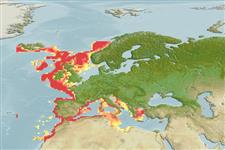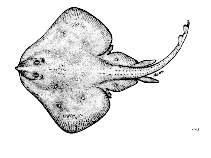Leucoraja circularis (Couch, 1838)
Sandy ray
مشاهدات خود را اضافه کنيد در Fish Watcher
| Native range | All suitable habitat | Point map | Year 2050 |

|
| This map was computer-generated and has not yet been reviewed. |
| Leucoraja circularis AquaMaps Data sources: GBIF OBIS |
را بارگذاری کني تصاوير و فيلم ها
Pictures | تصوير گوگلLeucoraja circularis
Picture by FAO
Pictures | تصوير گوگلLeucoraja circularis
Picture by FAO
United Kingdom country information
Common names:
Morgath gron, Sandy ray, Sandy ray
Occurrence: native
Salinity: marine
Abundance: scarce (very unlikely) | Ref: Swaby, S.E. and G.W. Potts, 1990
Importance: | Ref:
Aquaculture: | Ref:
Regulations: | Ref:
Uses: no uses
Comments: Occasionally caught in the northern North Sea and Celtic Sea (108-432 m) (Ref. 82399).
National Checklist:
Country Information: https://www.cia.gov/library/publications/resources/the-world-factbook/geos/uk.html
National Fisheries Authority:
Occurrences: Occurrences Point map
Main Ref: Stehmann, M., 1990
National Database:
Occurrence: native
Salinity: marine
Abundance: scarce (very unlikely) | Ref: Swaby, S.E. and G.W. Potts, 1990
Importance: | Ref:
Aquaculture: | Ref:
Regulations: | Ref:
Uses: no uses
Comments: Occasionally caught in the northern North Sea and Celtic Sea (108-432 m) (Ref. 82399).
National Checklist:
Country Information: https://www.cia.gov/library/publications/resources/the-world-factbook/geos/uk.html
National Fisheries Authority:
Occurrences: Occurrences Point map
Main Ref: Stehmann, M., 1990
National Database:
Common names from other countries
رده بندی / Names اسامي عام | مترادف | Catalog of Fishes(جنس, گونه ها) | ITIS | CoL | WoRMS | Cloffa
(كوسه ها و سپرماهيان) (sharks and rays) > Rajiformes (Skates and rays) > Rajidae (Skates)
Etymology: Leucoraja: Greek, leykos = white + Latin, raja = a fish, Raja sp. (Ref. 45335).
Etymology: Leucoraja: Greek, leykos = white + Latin, raja = a fish, Raja sp. (Ref. 45335).
Environment: milieu / climate zone / depth range / distribution range بوم شناسي
دريايي نزديك كف زي; تغييرات عمق 10 - 800 m (Ref. 106604). Temperate; 67°N - 27°N, 25°W - 37°E
پراكنش كشورها | مناطق سازمان خوار و بار جهاني (FAO) | Ecosystems | ظهور | Point map | معرفي | Faunafri
Eastern Atlantic (Iceland, southern Norway, Skagerrak and Morocco) and the Mediterranean Sea.
Records as far south to Mauritania and Senegal could not be verified due to lacking descriptions and specimens; most are probably misidentifications of Leucoraja leucosticta.
Size / Weight / سن
Maturity: Lm ? range ? - ? cm
Max length : 120 cm TL جنس نر / بدون خواص جنسي; (Ref. 4426); 117.0 cm TL (female); common length : 70.0 cm TL جنس نر / بدون خواص جنسي; (Ref. 4426)
Max length : 120 cm TL جنس نر / بدون خواص جنسي; (Ref. 4426); 117.0 cm TL (female); common length : 70.0 cm TL جنس نر / بدون خواص جنسي; (Ref. 4426)
توصيف مختصر كليدهاي شناسايي | ريخت شناسي | ريخت ستجي بوسيله انداره گيري
خارهاي باله پشتي (کل) : 0; خارهاي باله مخرجي: 0. Snout short, its tip somewhat pronounced; upper surface entirely spinulose, about 8 thorns generally in a complete row around inner margin of eye and a triangle of thorns on nape or shoulder region; underside with prickles only on snout, between gill-slits, along abdomen, and at anterior margins of disc; tail only slightly longer than body; upper surface reddish-brown to dark brown with 4-6 creamy spots on each wing, underside white (Ref. 3167).
Found in offshore shelf waters and on upper slope, mainly around the 100 m line (Ref. 3167). Depth range from 70-275 m (Ref. 03167), and from 463-676 m in eastern Ionian Sea (Ref. 56504). Feed on all kinds of bottom animals (Ref. 3167). Oviparous. Distinct pairing with embrace. Young may tend to follow large objects, such as their mother (Ref. 205). Eggs are oblong capsules with stiff pointed horns at the corners deposited in sandy or muddy flats (Ref. 205). Egg capsules are 8.3-9.2 cm long and 4.6-5.3 cm wide (Ref. 41303, 41251, 41311). Maximum length for female is 117 cm (Ref. 41333).
Life cycle and mating behavior بلوغ | تولید مثل | تخم ریزی | تخم ها | Fecundity | توزاد ( لارو)
Oviparous, paired eggs are laid. Embryos feed solely on yolk (Ref. 50449). With no definite egg laying period (Ref. 3167). Distinct pairing with embrace. Young may tend to follow large objects, such as their mother (Ref. 205).
مآخذ اصلی
Upload your references | مراجع | هماهنگ كننده : McEachran, John | همكاران
McEachran, J.D. and K.A. Dunn, 1998. Phylogenetic analysis of skates, a morphologically conservative clade of elasmobranchs (Chondrichthyes: Rajidae). Copeia 1998(2):271-290. (Ref. 27314)
وضعيت در فهرست قرمز IUCN (Ref. 130435: Version 2024-2)
در معرض خطر (EN) (A2bcd); Date assessed: 30 October 2014
خطر برای انسان ها
Harmless
استفاده انسانی
ماهي گيري – شيلات: ارزش تحاري اندك
FAO(ماهي گيري – شيلات: production; publication : search) | FishSource | Sea Around Us
اطلاعات بيشتر
Population dynamics
Growth parameters
Max. ages / sizes
Length-weight rel.
Length-length rel.
نوسانات طولی
Mass conversion
بازسازی
فراواني
Growth parameters
Max. ages / sizes
Length-weight rel.
Length-length rel.
نوسانات طولی
Mass conversion
بازسازی
فراواني
Physiology
Body composition
Nutrients
Oxygen consumption
Swimming type
Swimming speed
Visual pigments
Fish sound
Diseases & Parasites
Toxicity (LC50s)
Body composition
Nutrients
Oxygen consumption
Swimming type
Swimming speed
Visual pigments
Fish sound
Diseases & Parasites
Toxicity (LC50s)
ابزارها
E-book | راهنماي صحرايي | كليدهاي شناسايي | امكان نرم افزاري بسامد طولي | ابزار تاريخ زيستي | نقشه نقطه ای | Classification Tree
| Catch-MSY |
گزارش های ويژه
راجع به نگهداری آکواريم ملاحظه کنيد | برگه اطلاعات و مشخصات گونه ها را ملاحظه کنيد | برگه اطلاعات و مشخصات آبزی پروری را ببينيد
بارگيری XML
صفحه خلاصه | Point data | اسامي عام | تصاوير
منابع اينترنتي
Aquatic Commons | BHL | Cloffa | Websites from users | فيش واچر را ببينيد | CISTI | Catalog of Fishes(جنس, گونه ها) | DiscoverLife | ECOTOX | Faunafri | Fishtrace | GenBank(ژنوم, نوکلئوتيد) | GloBI | GOBASE | | Google Books | Google Scholar | Google | IGFA World Record | MitoFish | پايگاه هاي داده ها | Otolith Atlas of Taiwan Fishes | PubMed | Reef Life Survey | Scirus | SeaLifeBase | Tree of Life | Wikipedia(برو, جستجو) | World Records Freshwater Fishing | Zoological Record
Estimates based on models
Preferred temperature (Ref. 115969): 7.5 - 14.2, mean 11.3 (based on 116 cells).
Phylogenetic diversity index (Ref. 82804): PD50 = 0.5000 [Uniqueness, from 0.5 = low to 2.0 = high].
Bayesian length-weight: a=0.00269 (0.00166 - 0.00436), b=3.20 (3.06 - 3.34), in cm Total Length, based on LWR estimates for this species & Genus-body shape (Ref. 93245).
Trophic level (Ref. 69278): 3.5 ±0.37 se; based on food items.
جهندگی (Ref. 120179): پايين ، كم, كمينه زمان لازم براي دو برابر شدن جمعيت 5/4 – 14 سال (Fec assumed to be <100).
Fishing Vulnerability (Ref. 59153): High to very high vulnerability (72 of 100).
Climate Vulnerability (Ref. 125649): Moderate to high vulnerability (48 of 100).




